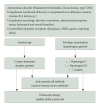Autoimmune Gastritis: Unveiling the Mystery
- PMID: 40550545
- PMCID: PMC12173590
- DOI: 10.7704/kjhugr.2025.0011
Autoimmune Gastritis: Unveiling the Mystery
Abstract
Atrophic gastritis is primarily caused by Helicobacter pylori infection and autoimmune mechanisms. In South Korea, where H. pylori infections remain highly prevalent, standardized guidelines for the use of serological testing or biopsies for diagnosing autoimmune gastritis (AIG) have not been developed. Recently, as H. pylori infection rates have declined and trends associated with gastric cancer and gastric neuroendocrine neoplasms (gNENs) have shifted, interest in AIG has increased, particularly in Asia. However, AIG diagnoses are often delayed owing to a lack of suspicion; even when AIG is considered, the limited understanding of the disease hampers its accurate diagnosis. Furthermore, the absence of established treatments and standardized follow-up protocols pose significant challenges for patient management. The loss of gastric acid secretion, a critical component of digestive function, and destruction of the gastric corpus mucosa are caused by autoimmune mechanisms, leading to incomplete protein digestion, micronutrient deficiencies, gut microbiota imbalances, and elevated gastrin levels that eventually contribute to neoplastic lesions, such as gNENs and gastric cancer. Although AIG is an immunerelated gastrointestinal disorder, it intersects with various disciplines, including pathology, genetics, microbiology, endocrinology, hematology, and oncology, and many unresolved issues remain in these areas. Research to address unanswered questions about the disease pathogenesis, the relationship between AIG and H. pylori, appropriate diagnostic methods and the risk of gastric neoplasms has previously been published. This review provides an overview of the current findings and explores unanswered questions surrounding AIG to help elucidate its complex pathogenesis, clinical implications, and potential management strategies.
Keywords: Autoimmune diseases; Gastric parietal cells; Gastritis; Helicobacter pylori; Stomach neoplasms.
Conflict of interest statement
The authors have no financial conflicts of interest.
Figures




References
-
- Pimentel-Nunes P, Libânio D, Marcos-Pinto R, et al. Management of epithelial precancerous conditions and lesions in the stomach (MAPS II): European Society of Gastrointestinal Endoscopy (ESGE), European Helicobacter and Microbiota Study Group (EHMSG), European Society of Pathology (ESP), and Sociedade Portuguesa de Endoscopia Digestiva (SPED) guideline update 2019. Endoscopy. 2019;51:365–388. - PubMed
-
- Lenti MV, Rugge M, Lahner E, et al. Autoimmune gastritis. Nat Rev Dis Primers. 2020;6:56. - PubMed
-
- Lamberti G, Panzuto F, Pavel M, et al. Gastric neuroendocrine neoplasms. Nat Rev Dis Primers. 2024;10:25. - PubMed
Publication types
LinkOut - more resources
Full Text Sources

